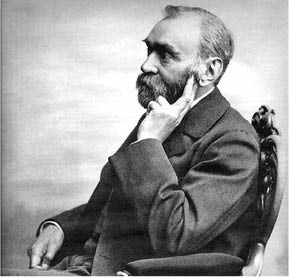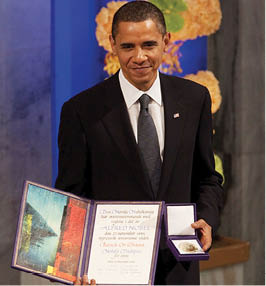Getting Around Stockholm

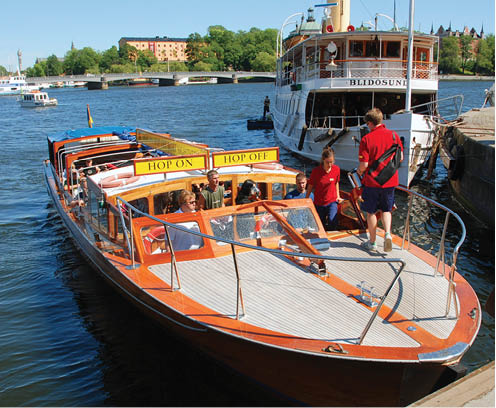
Hop-On Hop-Off Boats are an ideal way to explore the city.
Most ships embarking and disembarking passengers in Stockholm will dock at the Frihamnen cruise terminal, located about two miles (3 km) northeast of Gamla Stan (about 10 minutes by taxi; 20 minutes by public bus). Ships making a port call in Stockholm will dock at one of several cruise piers in the city’s harbour, or possibly pull into Nynashamn, located 37 miles (60 km) south of Stockholm. Passengers tendered ashore at Nynashamn can reach Stockholm by train, shore excursion or motorcoach shuttle; trains run twice hourly to Stockholm.
The main cruise pier in Stockholm’s harbour is Stadsgarden, on the island of Sodermalm, which is connected by bridges to Gamla Stan. (Small ships often dock right at Gamla Stan.) It takes about 30 minutes to walk the 2.5 miles (4 km) from Stadsgarden into the city centre (follow the blue line). A less strenuous way to get there is to take the Hop-On Hop-Off Boat that docks near the Stadsgarden cruise quays opposite Fotografiska (Photography Museum). An all-day ticket (160 kronor) can be pre-purchased online (stromma.se) or you can purchase a single-use ticket (40 kronor)when boarding the boat and ride it to the Nybroplan dock where a ticket booth sells all-day tickets. An all-day ticket allows you to disembark and re-embark at various stops around the harbour, and this can be combined with the red Hop-On Hop-Off Bus, which follows a route past most of Stockholm’s sights. Bus passengers can get on and off at any of the 21 stops, including the cruise piers at Stadsgarden and Frihamnen. A combination all-day bus-and-boat ticket is 380 kronor; an all-day ticket for the Red Sightseeing buses is 260 kronor.
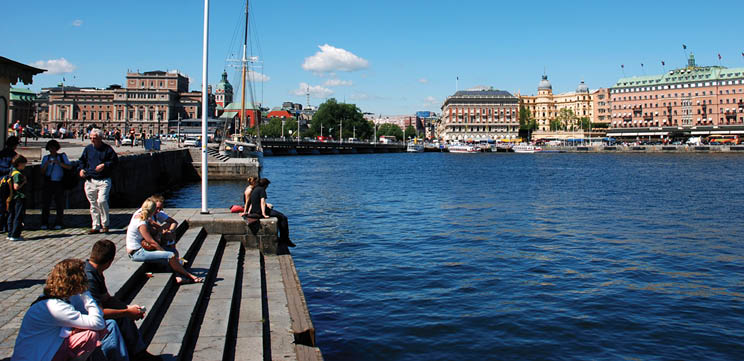
Stockholm’s harbour.
Most cruise lines offer an all-day shuttle service into Gamla Stan from Stadsgarden or Frihamnen that drops off in front of the National Museum or the Royal Opera. You can also take the public bus (6 kronor) from the cruise piers into Gamla Stan. Taxis are available, but expensive (credit cards accepted).
Stockholm’s airport is connected to the city centre by high-speed trains (the Arlanda Express), which depart every 15 minutes on the 20-minute journey between the airport and the central train station in Norrmalm (the city’s business and shopping area). The same trip by taxi takes about 45 minutes. An airport shuttle services the major downtown hotels. The Stockholm Card (525 kronor for one day) provides free access to museums, attractions, public transportation and sightseeing boats.
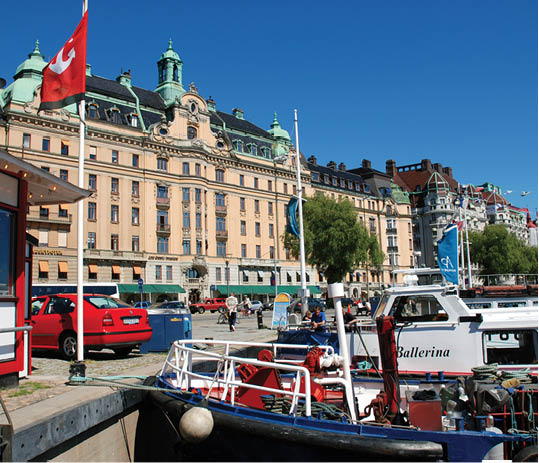
The Nybroplan waterfront
Hotels near the Arlanda Express train station include the four-star Nordic Light Hotel and Nordic Sea Hotel, which is home to the world’s first Absolut Icebar. A few blocks south of central station, near the waterfront, is the Sheraton Stockholm Hotel. The stately five-star Grand Hotel is a city landmark overlooking the harbour that opened its doors in 1874.
The Hilton Stockholm Slussen is located on the Sodermalm waterfront, opposite Gamla Stan, and just a few minutes’ walk from many of the significant sites mentioned in the Millennium Trilogy. (Guides at the nearby Stockholm City Museum lead Millennium tours of the area.)
Map of Stockholm
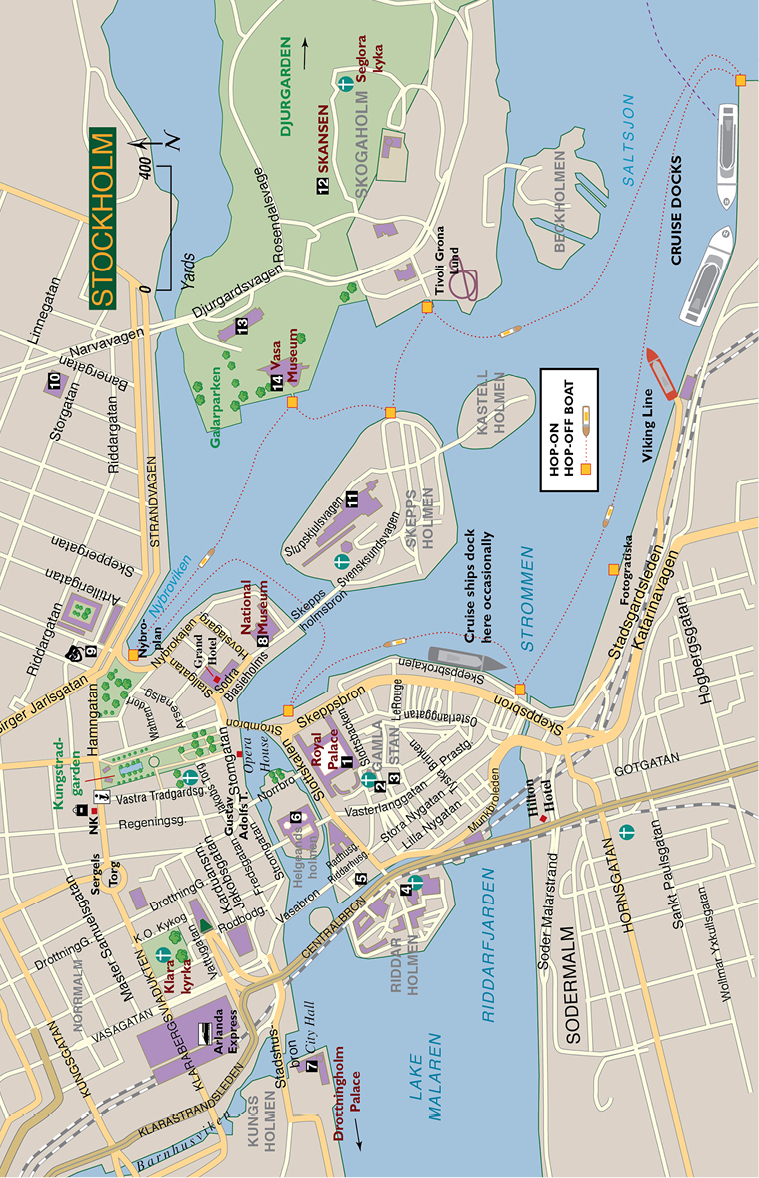
Smorgasbord is a Swedish dining tradition and the most elegant place in town to enjoy this classic Scandinavian feast is at the Grand Hotel’s Veranda restaurant, which serves six courses of delicacies, including herring dishes and smoked salmon.
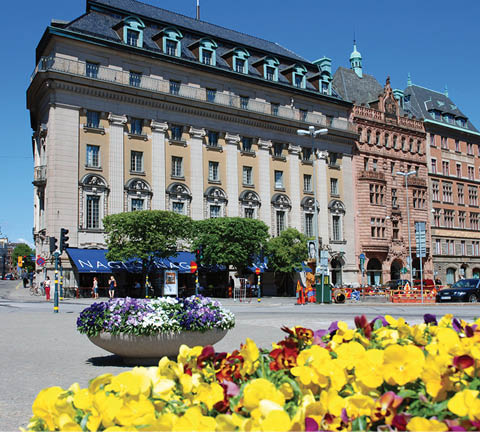
Naglo restaurant at Gustav Adolfs Torg.
Den Gyldene on Osterlanggatan in Gamla Stan is Stockholm’s oldest restaurant, serving classical Swedish dishes in a candle-lit setting. More restaurants and cafés are located along Storkyrkobrinken (which leads from the House of Nobility to the Cathedral) and Trangsund (which winds from the Cathedral to the Great Square).
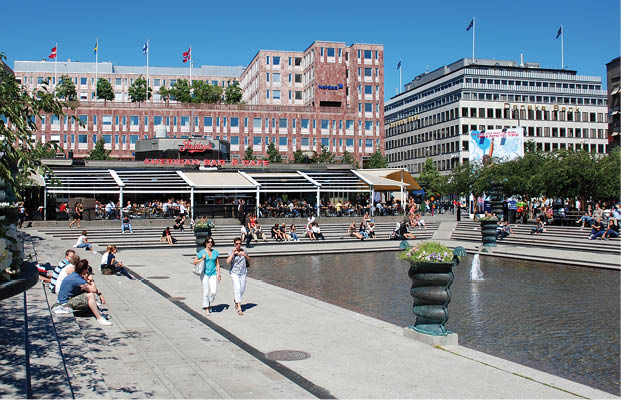
King’s Garden
Kungstradgarden (King’s Garden) in Norrmalm is where locals and tourists come to enjoy restaurants at either end of the tree-lined park with its sunken fountain, outdoor chess matches and live performances on the tent-covered stage.
Sweden is famous for its fine glassware, stainless steel kitchenware and Nordic folk art, including brightly painted wooden handicrafts.
The city’s main shopping area is centred around Sergels Torg, near the northwest corner of King’s Garden, which is where the department store NK (Nordiska Kompaniet) is located.
Crystalware by Orrefors and Kosta Boda is available at their outlet on Birger Jarlsgatan (a few blocks from Nybroplan) and at Nordika Kristall (Kungsgatan 9), which houses an art-glass gallery. Another Nordika Kristall outlet is located in Gamla Stan on Osterlanggatan.
The famous interior design store Svenskt Tenn is located on Strandvagen, a waterfront boulevard leading off Nybroplan.
Souvenir shops are concentrated on Vasterlanggatan and Osterlanggatan in Gamla Stan.
Value Added Tax (VAT) is added to most purchases but can be re-claimed on large amounts with a Tax Free Receipt issued by participating retailers.
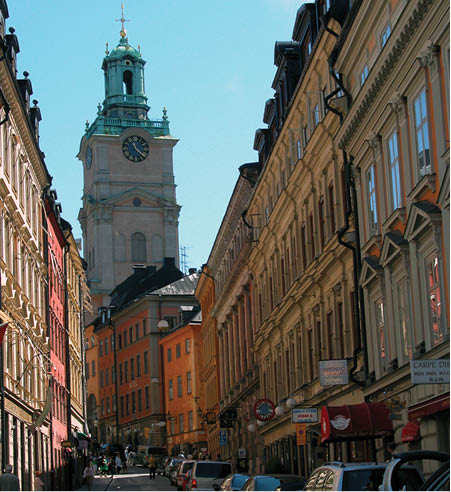
Storkyrkobrinken in Gamla Stan.
Gamla Stan, the historic heart of Stockholm, occupies three interconnected islands and contains numerous historic buildings as well as shops, restaurants and outdoor cafes. The adjacent mainland is where the city’s shopping and theatre district is located. The main tourist information centre is located on the north side of King’s Garden (Kungstradgarden) in Norrmalm.
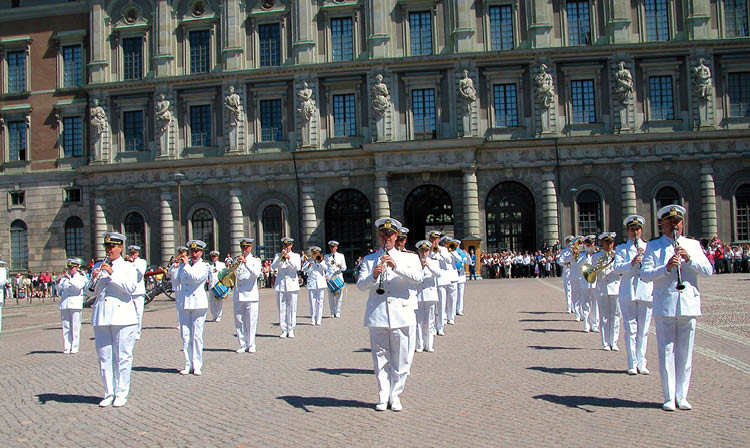
Military bands perform at the Royal Palace during the daily changing of the guard.
1. The Royal Palace – A highlight for most visitors, especially if you time your arrival in its outer courtyard to coincide with the mid-day Parade of Guards held daily in June, July and August (12:15 Monday-Saturday; 1:15 Sunday and official holidays). This massive palace was built in the Italian baroque style and completed in 1754, replacing the original medieval castle which was destroyed by fire in 1697 (apart from the north wing). It contains 680 rooms, which include offices for members of the royal family and their staff. Parts of the palace are open to the public, and guidebooks are sold at the entrance desks. Guided tours are also available. Highlights include the State Apartment (where gala banquets are held during state visits), the Bernadotte Apartments, and the Royal Chapel. Museums within the palace walls include the Tre Kronor Museum (with exhibits on the original medieval castle), Gustav III’s Museum of Antiquities (displaying classical sculptures), the Treasury (containing the state regalia) and the Royal Armoury, housed in the palace vaults.
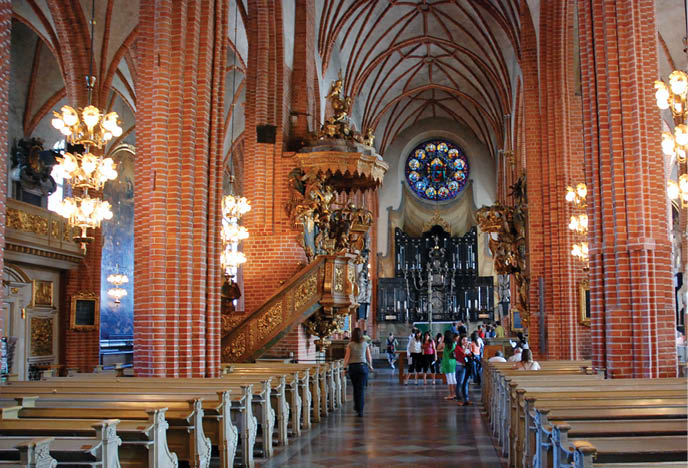
The interior of Stockholm’s cathedral.
2. Stockholm’s cathedral – This churhc, called Storkyrkan (Great Church), began as a village church in the late 13th century. Rebuilt following a fire, the church underwent major conversions throughout the 15th century and emerged as a late-Gothic structure. Lavish adornment was added in the 17th century and highlights include a 12-foot-high bronze candelabra and a 15th-century altar monument depicting St. George slaying a dragon. In 1942 the church received cathedral status. Royal weddings, coronations and baptisms take place in the cathedral, with Crown Princess Victoria marrying Daniel Westing here on June 19, 2010.

A statue of Stockholm’s founder stands in the centre of Birger Jarls Torg.
3. Stortorget (Great Square) – This is the oldest square in Stockholm, located immediately south of the cathedral. It is relatively small compared to the main squares of other medieval cities and is surrounded on three sides by tall narrow houses originally owned by wealthy merchants and shopkeepers. The only civic building – the Stock Exchange Building – stands on the square’s north side. This 18th-century, French rococo building currently houses the Swedish Academy, Nobel Library and Nobel Museum, which was inaugurated in 2001 and celebrates the work and ideas of Nobel laureates over the past century. The museum is open daily in summer, from 10 am to 5 pm, and guided tours in English are at 11:15 am and 3 pm.

Riddarholm Church
4. Riddarholm Church – Riddarholmen (Knights’ Island) contains numerous 17th-century palaces (now civic buildings) such as those surrounding the central public square of Birger Jarls Torg, in the centre of which stands a statue depicting Birger Jarl, founder of Stockholm. Nearby is Riddarholm Church, easily spotted with its distinctive openwork metal spire. Swedish kings and queens have been buried here since 1290. Chapels containing monumental tombs and marble sarcophagi line both sides of the nave. The coats of arms of the Knights of the Seraphim hang on the walls.
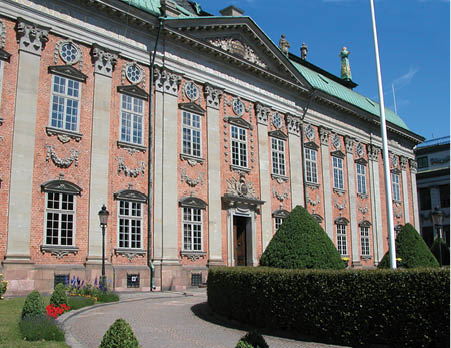
House of Nobility
5. The House of Nobility (Riddarhuset) – This house was built in the mid-1600s (two wings were added in 1870) to hold meetings of Swedish nobility during the Swedish parliament’s Diet (Assembly) of Four Estates (nobles, clergy, burghers and peasants). Hanging on the walls are the coats of arms of aristocratic families that have, over the centuries, belonged to the House of Nobility. Also on display is a 17th-century chair carved in ivory and ebony.
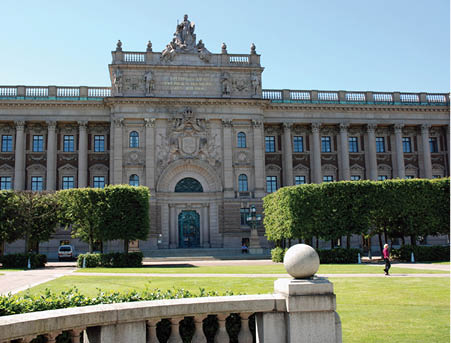
Riksdag
6. The Riksdag (Sweden’s parliament) – Housed in a late 19th-century building on the island of Helgeandsholmen, which is connected by bridges to the main part of Gamla Stan opposite the Royal Palace. The Riksdagshuset’s curved facade faces west, and an information centre outside the main entrance is where you can sign up for a guided tour.
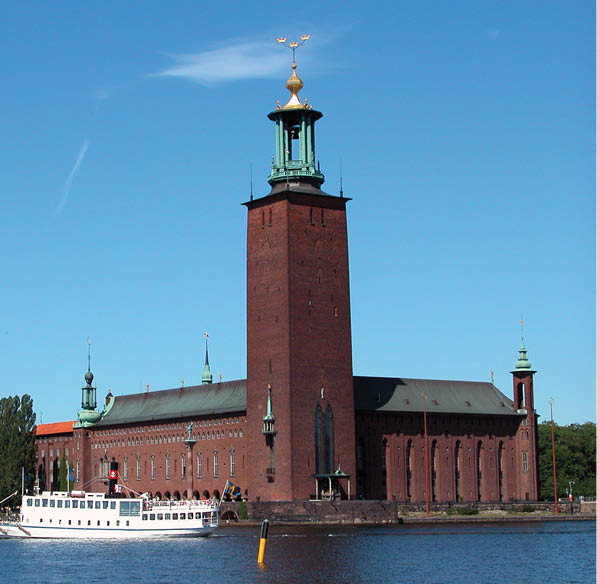
City Hall.
7. City Hall (Stadshuset) – Built between 1911 and 1923, the City Hall is situated on King’s Island overlooking Lake Malaren. Designed by Swedish architect Ragnar Osterberg, the red-brick building is a modern interpretation of the Scandinavian Renaissance style. Take an elevator or walk the 365 steps to the bell tower, which offers panoramic views over Stockholm. City Hall is famous worldwide for the annual Nobel Banquet held in its Blue Hall. Guided tours only are available of this ceremonial hall and of the Golden Hall (splendid with gold mosaics). Daily tours in English are held on the hour (except 1 pm) from 10 am to 3 pm, June through August. Most cruise lines offer organized shore tours of City Hall.
8. The National Museum – Sweden’s largest art museum, housed in a 19th-century building which faces, across the water, the Royal Palace. The museum’s vast collection of fine and decorative art includes drawings, paintings and sculptures. Dutch and Flemish artists, such as Rembrandt and Rubens, are represented, as are numerous 18th-century French artists. The museum also houses an art library and restaurant. Open daily in summer; admission is 100 SEK.
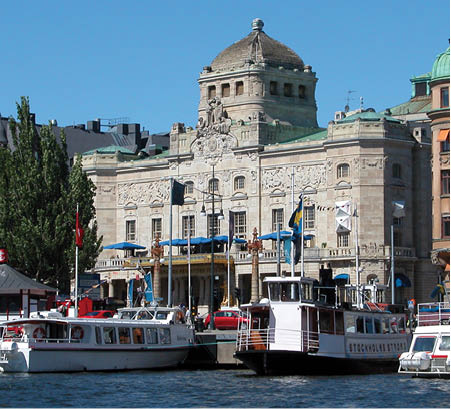
Royal Dramatic Theatre
9. The Royal Dramatic Theatre – Founded in 1788, this theatre is famous for its acting school, which produced a long list of famous actors and directors including Ingmar Bergman, Greta Garbo, Ingrid Bergman, Bibi Andersson and Max von Sydow.
10. History Museum – East of the Royal Dramatic Theatre, in the upscale residential district of Ostermalm, is the History Museum (Historiska Museet), which features historic Viking exhibits.
11. The Moderna Museet (Museum of Modern Art) – Located on the harbour island of Skeppsholmen and houses a comprehensive collection of modern art, including works by Dali, Picasso, Matisse and Andy Warhol. (Admission is 120 SEK; closed Mondays.)
Djurgarden, once a royal hunting grounds, is a park-like island of green spaces and outdoor attractions, including a harbourside amusement park called Tivoli Grona Lund. Besdie it is the new ABBA Museum, dedicated to the legendary Swedish disco group of the 1970s with extensive displays of memorabilia and stage costumes, and interactive exhibits such as a vocal recording booth.
12. Skansen – Nearby is the sprawling open-air museum at Skansen, which replicates pre-industrial Sweden with traditional farm houses, a manor house and a 19th-century town.
13. Nordic Museum – This museum, alongside Skansen, was founded by the 19th-century Swedish scholar Artur Hazelius whose goal was to preserve Swedish folk culture before it was completely eroded by modern industrialization. The Nordic Museum is housed in a late-19th-century building designed in the Danish Renaissance style.

Vasa Museum and Nordic Museum to its left.
14. Vasa Museum – A popular attraction on Djurgarden, this museum is home to the only surviving example of a 17th-century warship. Sweden was an ascending sea power when King Gustavus Adolphus ordered the construction of the 64-gun Vasa at the dockyard in Stockholm, where she was launched amid much fanfare in August 1628. The Swedish king was away at the time, waging war in Poland, and didn’t witness the disaster viewed by the hundreds of spectators lining the shoreline. Hailed as the mightiest warship ever built, the Vasa had barely left the ways when she began to heel over, take on water through her open gunports, and sink 110 feet to the bottom of the harbour where she lay in her muddy grave for over 300 years.
The raising of the Vasa took place on April 24, 1961, and the entire country watched the televised event. To prevent the wooden hull from breaking up, it had been slowly raised into shallow water before the final lift to the surface. To prevent decay the moment the ship was exposed to air, all woodwork was promptly treated with a preservative. The ship is now on display in the specially built, climate-controlled Vasa Museum, as are many of the preserved artifacts found on board the ship. The museum is open daily; admission is 130 SEK. The gift shop sells books, prints and replicas of jewellery and other items recovered from the Vasa.
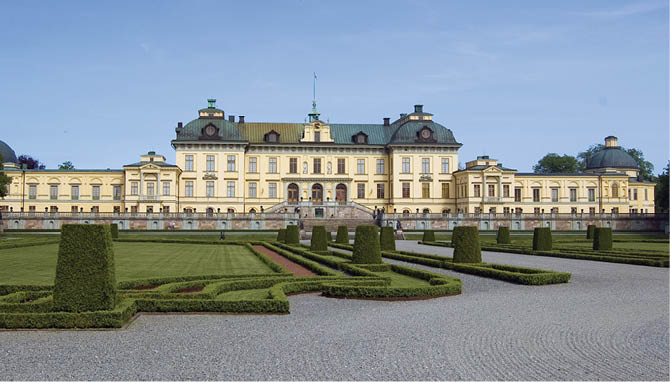
Drottningholm Palace
If you’re spending more than a day in Stockholm, consider a visit to Drottningholm Palace, which is a UNESCO World Heritage Site. This palace has been the Swedish royal family’s official residence since 1981, when King Carl Gustav and Queen Silvia decided its parklike setting was more suitable for raising a young family. Beautifully situated on Lovon Island, overlooking Lake Malaren, the 18th-century palace and formal gardens were inspired by the Palace of Versailles, but on a smaller scale. Much of the palace, including its perfectly preserved theatre, is open to public tours. Queen Desiree, the French-born consort to King Charles XIV (founder of the House of Bernadotte), spent her summers at Drottningholm – a welcome respite after the long, dark, snowladen months of a Swedish winter. In summer, a one-hour tour-boat ride can be taken from the City Hall jetty to Drottningholm Palace.
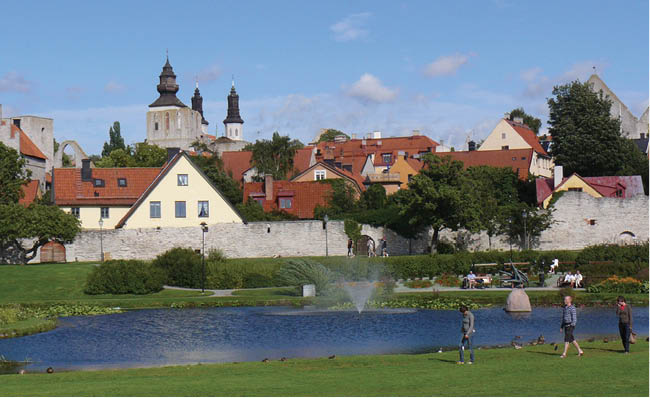
Almedalen Park, near the seafront in central Visby.
A small city on Gotland Island, Visby is a popular summer resort with its preserved medieval architecture and rose-filled gardens. Cruise ships anchor in the harbour and tender their passengers ashore where the walled town is easy to explore on foot. A ship’s biking tour is a good way to see more of the island.
Visby began as a Viking settlement, trading port and pagan religious centre. When German merchants of the Hanseatic League settled here in the 11th century, they established Visby as a commercial centre, building stone fortifications and numerous churches. Today, the medieval walled town is a UNESCO World Heritage Site. The Ring Wall encircles the town’s winding cobblestone streets and Gothic church ruins. On warm summer days, visitors linger at the sidewalk cafés or browse the boutiques selling crafts, clothing and jewellery such as pendants replicating Norse talismans made with ancient moulds. Historical highlights include the restored Cathedral of St. Mary’s with gargoyles carved into fantastic beasts, demons and angels, and the Historical Museum’s two dozen exhibit halls, including the medieval collection housed in a 13th-century warehouse.
From the late 13th-century until the mid-17th century, Gotland changed hands several times between the Danes, Swedes and Hanseatic League, until finally becoming a possession of the Swedish crown.
Gotland, which is a limestone plateau with a steep coastline and few hills, has fertile soil for farming and sheep raising. Its major industries are fishing, cement making and tourism. A ferry connects the north end of Gotland to its smaller, sister island of Faron. Also known as Faro, this remote rural island of fine beaches was the decades-long home of the renowned and reclusive movie director Ingmar Bergman.

Steps lead to Helsingborg’s Danish-built fortress.
The port of Helsingborg is popular for its access by ferry across the narrow Øresund strait to Helsingor – home of the Danish castle famous as the setting of Shakespeare’s Hamlet. Other attractions in Helsingborg are its medieval tower built by the Danes over six centuries ago when the Danish crown controlled both sides of the Øresund. Massive fortresses stood on either side of the strait to exact a levy from all trading vessels passing through its narrowest part. With a population approaching 100,000, Helsingborg is a pleasant city of stone-built churches, half-timbered houses and a pedestrian shopping street (Sweden’s first). It is also the international corporate headquarters of Ikea.
Helsingborg shore excursions include guided walking tours, ferry trips to Helsingor to visit Kronborg Castle, and driving tours to Sofiero Castle – the favourite summer residence of King Gustav VI Adolf with its beautiful gardens and expansive lawns, which are sometimes used for large outdoor concerts, including performances by Bob Dylan and Bryan Adams.
Sweden’s second-largest city and major shipping port. Gothenburg is situated at the mouth of the Gota alv River. Cruise ships dock at one of several quays: Arendal and Skandia are in the outer harbour, about 20 minutes from the city centre on a ship’s shuttle bus; America Quay accommodates small cruise ships and is just over a mile (2 km) from the city centre, which can be reached by tram or ship’s shuttle; Freeport (Frihamnen) is less than a mile (about 1 km) from the city centre, reached by walking over a bridge.
Founded in 162l, Gothenburg thrived as a trading port, with wealthy merchants building imposing stone houses alongside the city’s canals. Modern industrial wealth (Volvo was founded here in 1927) is reflected in the city’s numerous parks, gardens, and museums. The charming pedestrian street of Haga Nygata is lined with preserved wooden houses, boutiques and cafés. Gothenburg is known for its seafood restaurants and the local fish market, housed in a church-like hall built in 1874, draws visitors to its fresh shrimp stands.
